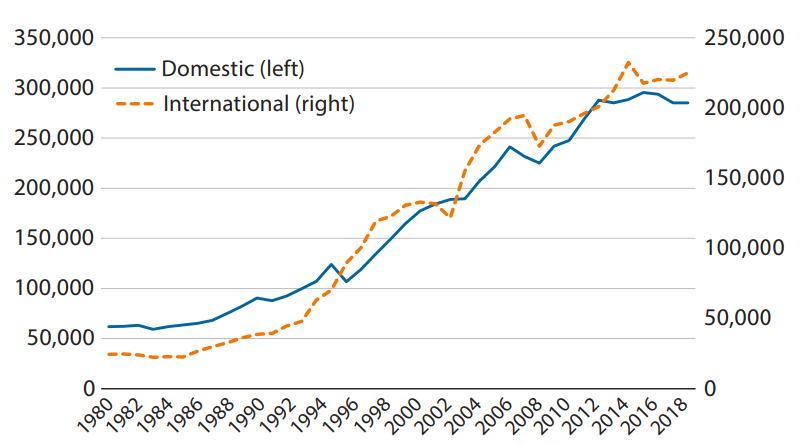U.S. Patent Applications Shift toward Asia
Inventors seek patents to protect their intellectual property (IP), not only in their own country but in countries where they seek to do business. Can changes in patterns of international patenting reveal international business trends?
In a 2021 Economic Synopses essay, St. Louis Fed Senior Economist Ana Maria Santacreu and Research Associate Jesse LaBelle examined this question by studying shifts in the foreign markets where U.S. innovators apply for patents.
Divergent Growth between International and Domestic Patenting
The authors found that while U.S. patent applications, both domestically and abroad, have increased, the growth in international patenting of U.S. inventions was much faster than the growth in domestic patenting: 819% versus 359%, respectively, from 1980 to 2019. (This can be seen in the figure below, which is from the Economic Synopses essay.)
The Evolution of Domestic and Foreign Patenting of U.S. Innovations (1980-2019)

SOURCES: PATSTAT Worldwide Patent Statistical Database - EPO, World Intellectual Property Organization statistics database and authors’ calculations.
International Patenting: A Shift in Locations
Santacreu and LaBelle then examined the foreign markets where U.S. inventors sought patents. They found a shift toward Asia since the creation of the World Trade Organization (WTO) in 1995, noting the following:
- Before the WTO, Canada, Mexico and Brazil had the most patent applications from U.S. innovators. Since the WTO, the three countries have been replaced by Japan and China.
- Before WTO, South Korea, Japan and China were the only Asian countries among the top 20 countries to receive such applications. Since then, India, Hong Kong, Singapore, Malaysia and Thailand are other Asian countries that have joined the top 20.
The authors also found that China has been the primary beneficiary of this shift toward Asia. They noted that China is on track to become the largest recipient of patent applications from U.S. inventors within a couple years; Japan currently has the top position.
The authors observed that China is an attractive investment location since it has the world’s largest population and a fast-growing gross domestic product per capita. Rising trade, multinational activity and licensing with China may be spurring demand for better IP protection through patent applications by foreign innovators, they noted.
“The world economy has become more integrated, not only through trade in goods and services but also through the sharing of ideas,” Santacreu and LaBelle concluded. “These trends have increased demand for cross-border IP protection.”
Citation
ldquoU.S. Patent Applications Shift toward Asia,rdquo St. Louis Fed On the Economy, June 7, 2022.
This blog offers commentary, analysis and data from our economists and experts. Views expressed are not necessarily those of the St. Louis Fed or Federal Reserve System.
Email Us
All other blog-related questions

